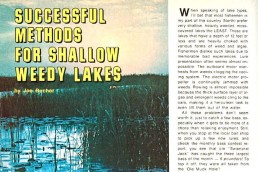Bucher on Big Game June, 2015
SHARE THIS POST
Hunting Early-season Muskies on Bass Tackle
Many muskie anglers make the mistake of not chasing after their favorite fish in the early season at all. Admittedly, I was as guilty as anyone in this regard until I started stumbling onto muskies consistently while bass fishing. Now, I seek them out while chasing bass. In other words, I fish both bass and muskies at the same time. I don’t target muskies with heavy tackle at this time of year much, unless an early ice-out combined with a warm spring shoots up water temps early. Instead, I love to catch ‘em on light stuff. Early season provides a rare opportunity to tangle with muskies of all sizes on spinning and light baitcasting gear. Calling this “fun” is putting it mildly. It’s a blast.
Above all else, there’s one pattern that has really worked for me with early muskies—finding warming water. I’m not saying every muskie in a given lake is in the warmest water area at this time of year. But muskies up in shallow warming water are simply more active. Essentially, this involves nothing more than heading for the northern end of a lake or reservoir. Bays and shallow extended flats on the north end are sure to receive the most sunlight and solar heat at this time of year. Any gamefish hanging out in this section of the lake is bound to get active by mid to late afternoon, as water temps rise.
The key to location is finding any kind of shallow cover. This could be a flat of dead reeds or some shallow weed growth. It might also be lily pads or a stump field. It might also be nothing more than a section of man-made docks and piers. But, like so many things in the wild outdoors, there are exceptions. The most startling is seeing big muskies cruising over clean bottom. I have seen a number of spring muskies openly cruising over clean bottom sandy flats with no cover at all. These fish are simply up in the shallow warm water soaking up solar heat.
Several other spots are worth considering depending upon the lake layout. The warmest water isn’t always found on the north side of a lake. Other factors can be a surprisingly strong influence on water temperature rise. One of the largest and most surprising is a shallow bay on the east or west side of the lake, or even the very southern end with an incoming creek. Muskies will often stack up at the mouth of a small inlet river or creek that pours in warmer water. Both the warm water and current seem to also attract lots of early-season baitfish.
Any lake connected to another by a channel in a chain-of-lakes situation is another classic example of a potentially good, warmer-water spot. The mouth of the channel between each lake is bound to have potential, as will the channel itself at times. This phenomenon exists across the country. The keys are to watch the temp gauge on your sonar unit and look for signs of fish activity. Generally, if you’re fishing a chain of lakes, you’ll find this situation somewhere inside that given body of water during the early portion of the muskie season.
Are you enjoying this post?
You can be among the first to get the latest info on where to go, what to use and how to use it!
Channels themselves can also be early muskie magnets. Of course, any channel with cover is apt to attract some baitfish and spawning panfish. That, in turn, automatically attracts muskies. However, not all channels are created equal. Narrow channels with higher shaded banks are rarely as good as ones that are sun baked and lined with small coves and toppled trees. Again, that’s why it is so important to have a temp gauge at this time of year, and to watch for signs of baitfish.
Many of our favorite muskie waters lack distinct bays, but do have large flats covered with reeds and bulrushes. Muskies gravitate heavily to reed flats with sunlight and calm water on lakes of this nature. This is one of my favorite early muskie locational patterns. I have taken advantage of this for nearly two decades while bass fishing.
I stumbled onto this deadly reed muskie pattern more than 20 years ago while casting spinnerbaits for bass. After five muskies in one afternoon on bass tackle, I was convinced. Since that outing, I have perfected seeking out muskies on sun-exposed reed flats, and look forward to this pattern every year. Many of you have watched me catch a number of these accidental muskies while bass fishing with a variety of tackle over the years, but honestly nothing beats a wacky worm presentation on these critters.
Most often, you will be able to see the muskie’s reaction to this bait. A fish that turns and swims off is a tougher one to catch. However, the right fish will perk up and approach the wacky worm as it falls. Sometimes, they will bolt right to it and attack all in one motion, while other times they will slide up, stop momentarily and then snatch it as soon as it moves again. In either case, set the hook as soon as you see the fish engulf the bait. However, take it real easy on the battle if you hook up with a big one on light tackle with no wire leader. Otherwise, they will either bite the line or break off.
Don’t wait for true summer to arrive before venturing out after a muskie. The early season offers its own opportunities to tag these crazy critters in shallow water with light tackle. Find warmer water and search out the available cover with a variety of lures. You can easily combine bass fishing with a little muskie action. The key is to keep a big fish hooked after the battle begins. But really, that’s half the fun.
MWO
SHARE THIS POST
You may also like...
0 CommentsJune is Transition Time for Michigan Muskies
Did you enjoy this post?
You can be among the first to get the latest info on where to go, what to use and how to use it!
Joe Bucher
Joe Bucher is a Freshwater Fishing Hall of Fame Legendary Angler, book author, lure designer and host of Fishing with Joe Bucher TV series.


